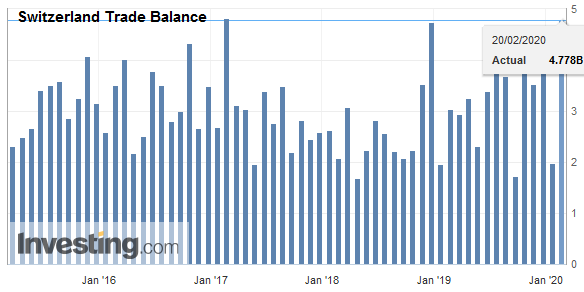We do not like Purchasing Power or Real Effective Exchange Rate (REER) as measurement for currencies. For us, the trade balance decides if a currency is overvalued. Only the trade balance can express productivity gains, while the REER assumes constant productivity in comparison to trade partners. Who has read Michael Pettis, knows that a rising trade surplus may also be caused by a higher savings rate while the trade partners decided to spend more. This is partially true. Recently Europeans started to increase their savings rate, while Americans reduced it. This has led to a rising trade and current surplus for the Europeans. But also to a massive Swiss trade surplus with the United States, that lifted Switzerland on the U.S. currency manipulation watch list. To
Topics:
George Dorgan considers the following as important: 2.) Swiss Statistics - Press Releases, 2) Swiss and European Macro, Featured, newsletter, Switzerland Exports, Switzerland Exports by Sector, Switzerland Imports, Switzerland Imports by Sector, Switzerland Trade Balance
This could be interesting, too:
Nachrichten Ticker - www.finanzen.ch writes Die Performance der Kryptowährungen in KW 9: Das hat sich bei Bitcoin, Ether & Co. getan
Nachrichten Ticker - www.finanzen.ch writes Wer verbirgt sich hinter der Ethereum-Technologie?
Martin Hartmann writes Eine Analyse nach den Lehren von Milton Friedman
Marc Chandler writes March 2025 Monthly
We do not like Purchasing Power or Real Effective Exchange Rate (REER) as measurement for currencies. For us, the trade balance decides if a currency is overvalued. Only the trade balance can express productivity gains, while the REER assumes constant productivity in comparison to trade partners.
Who has read Michael Pettis, knows that a rising trade surplus may also be caused by a higher savings rate while the trade partners decided to spend more. This is partially true. Recently Europeans started to increase their savings rate, while Americans reduced it. This has led to a rising trade and current surplus for the Europeans. But also to a massive Swiss trade surplus with the United States, that lifted Switzerland on the U.S. currency manipulation watch list.
To control the trade balance against this “savings effect”, economists may look at imports. When imports are rising at the same pace as GDP or consumption, then there is no such “savings effect”.
After the record trade surpluses, the Swiss economy may have turned around: consumption and imports are finally rising more than in 2015 and early 2016. In March the trade surplus got bigger again, still shy of the records in 2016.
Swiss National Bank wants to keep non-profitable sectors alive
Swiss exports are moving more and more toward higher value sectors: away from watches, jewelry and manufacturing towards chemicals and pharmaceuticals. With currency interventions, the SNB is trying to keep sectors alive, that would not survive without interventions.
At the same time, importers keep the currency gains of imported goods and return little to the consumer. This tendency is accentuated by the SNB, that makes the franc weaker.
| 20.02.2020 – Secondary sector production rose by 1.3% in 4th quarter 2019 in comparison with the same quarter a year earlier. Turnover rose by 0.3%. This rise has continued without interruption since the 1st quarter 2017 but was slightly weaker in the reporting quarter. This is shown by provisional results from the Federal Statistical Office (FSO).
In comparison with the previous year industrial production grew in October by 3.3%, in November by 2.7%, then fell in December (–1.1%). For the whole of 4th quarter 2019 production increased by 1.6% in comparison with the same quarter a year earlier. Construction production declined by 0.1% in 4th quarter 2019 in comparison with the same quarter a year earlier. Production declined by 1.2% in building, civil engineering in contrast registered an increase (+3.9%). Specialised construction activities recorded no growth in production. Turnover Industrial turnover in October rose by 1.9% in comparison with the previous year, and in November (+1.3%) and fell in December (–2.3%). For the whole of 4th quarter 2019 in comparison with the same quarter a year earlier, turnover registered an increase of 0.3%. Construction turnover rose by 0.2% in 4th quarter 2019 in comparison with the same quarter a year earlier. Turnover fell by 0.1% in building, civil engineering registered an increase of 4.5%, specialised construction activities a decline of 0.1%. |
Switzerland Trade Balance, January 2020(see more posts on Switzerland Trade Balance, ) Source: investing.com - Click to enlarge |
Download press release: Secondary sector shows positive growth rates again in 4th quarter 2019
Tags: Featured,newsletter,Switzerland Exports,Switzerland Exports by Sector,Switzerland Imports,Switzerland Imports by Sector,Switzerland Trade Balance
